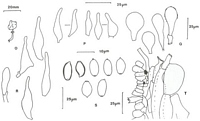|
 Conocybe rugosa Conocybe rugosa
SynonymsPholiota rugosa
BiostatusPresent in region - Origin uncertain
Images (click to enlarge)
Caption: O-T Segedin 1649, 0. Habit sketch; P. Cheilocystidia, Q. Pileipellis units; R. Caulocystidia; S. Basidiospores; T. LS. Section through hymenophoral trama. | 
Caption: J-N Taylor 1280, J. Basidioma and section; K. Cheilocystidia; L. Basidia; M. Basidiospores; N. Caulocystidia. |
Article: Watling, R.; Taylor, G.M. (1987). Observations on the Bolbitiaceae: 27. Preliminary account of the Bolbitiaceae of New Zealand. Bibliotheca Mycologica 117: 61 p. + 17 pl.
Description: DESCRIPTION OF NEW ZEALAND COLLECTION:
Pileus 27 mm, hemispheric, becoming convex to subcampanulate, golden tawny brown, sienna or cinnamon fawn when fresh, strongly hygrophanous, drying out whitish with ochraceous centre, dry, smooth, membranaceous; margin striate. Stipe 30-40 x 2.5 mm (base 5 mm), cylindric, annulate, white then fawn, apex pruinose, below ring longitudinally fibrillose or minutely squamulose, base dark brown, dry, fragile, hollow; ring mobile, whitish, persistent, striate-grooved above, pale woolly below. Gills adnexed to adnate, ventricose, dense, concolorous with fresh pileus or cinnamon to sienna, with whitish, minutely denticulate edge. Flesh white. Smell slight.
Basidiospores 8.5-9.5(-10.5) x 5-5.5 µm, elliptic in face-view slightly flattened in side-view, thick-walled, non-amyloid; germ-pore prominent, broad, central. Basidia 4-spored, clavate with short pedicel, 20-27 x 7 µm. Cheilocystidia lageniform with narrow tapered neck, 27-40 x 8-9 µm and obtuse apex 2-3 µm broad. Caulocystidia similar to those on gill-edge 42-51 x 9-17 µm, with apex 3-3.5 µm, intermixed with vesiculose cells, 23-32 x 9-13 µm. Pileipellis a palisadoderm of spheropedunculate cells 27-36 x 15-17 µm.
Notes: This collection agrees in all ways with Peck's fungus as interpreted by Walling (1982); see also van Waveren (1970). It is widespread in North temperate areas often in sites associated with human activity, e.g. in greenhouses and gardens. It is probably an introduction to New Zealand.
|